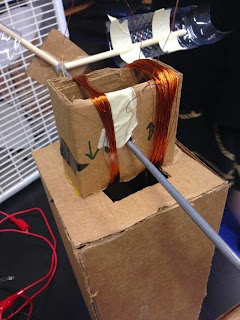Building a Wind Turbine
Materials I used to build my wind turbine:
1) cardboard - the base and the generator box
2) copper wire - to allow current to flow
3) hot glue - glue boxes together
4) a metal rod - the axle that allows the magnets to spin as the wings spin
5) 8 small magnets - creates a magnetic field
Electromagnetic induction is when a coil of wire is brought close to a magnet, inducing a voltage, and then causing a current.
Newton's 1st Law: An object at rest will stay at rest and an object in motion will stay in motion unless acted upon by an outside force.
--> The wings stay at rest until the fan made them spin.
Newton's 2nd Law: a = f/m
--> the more force (wind) the fan applied, the faster the wings spun, and the more mass the wings had the slower they went.
Newton's 3rd Law: Every action has an equal and opposite reaction.
--> Wind pushed wings -- wings pushed wind
When the wind blows the wings it creates a torque, causing the wings to spin and thus causing the magnets to spin.
Motors convert mechanical energy into electrical energy, so when the wings spin energy is created from electromagnetic induction.
This is our model. We used a tall cardboard box as the base, so the wings could spin easily without hitting the ground.
The smaller box on top of the base is our generator. Copper wire is coiled around the box on both sides. We had to be careful to wrap both coils in the same direction, so both currents would be going in the same direction.


We stuck a metal rod through the generator box for two purposes...
1) To allow the magnets something to stick on to.
2) To attach the wings on the ends, so when they spun the magnets would also spin thus inducing a voltage.
Inside the box are 8 small magnet - 4 on each side of the rod. Electrical tape is wrapped around them to make them stay close to each other. We want to have the same poles facing each other, so that the same poles are facing outward to create a magnetic field.
*If both north and south are facing outward, then there are two poles creating a magnetic field, which would mess up the electromagnetic induction process.
Same poles repel each other, so there is a strong repulsion when same poles are facing each other; thus we wrapped the magnets in electrical tape so it would be harder for them to get away from each other. This way the magnets can spin freely - without someone holding them together - when the axle spins as a result of the wings spinning.
The fan spins the blades, which spins the magnets in result and this changes the magnetic field of the wire. This changing of b induces a voltage and causes a current to flow resulting in a generation of electricity.
We generated .008V and .008A but we were not able to light the lightbulb, because we didn't generate enough voltage.
Factors that affect the amount of voltage induced:
1) Having both coils of copper wire wrapped in the same direction, so the current flows in the same direction in both coils.
2) Having the same poles facing outward, so they'll create a magnetic field.
One issue we ran into was friction. When our magnets spun, as a result of the wings spinning, they would rub up against the walls of the box, thus slowing down the speed of the wings.
If I were to do this project again I would make a bigger generator box, because when we needed to rearrange the magnets - when we learned that same poles need to be facing outwards - it was difficult to move them with the box being so small. I also recommend coiling the wire around your generator box as you're uncoiling it from it's original roll, because the wire gets easily tangled.



No comments:
Post a Comment